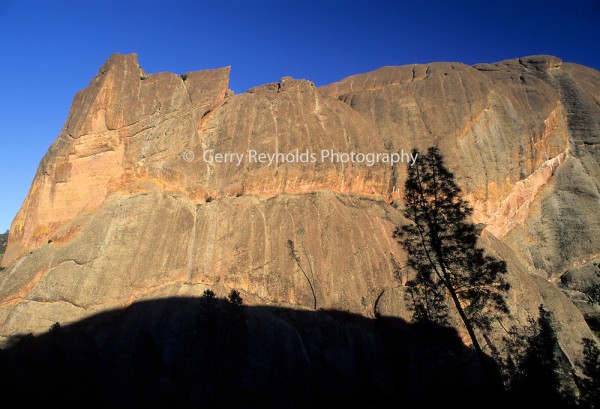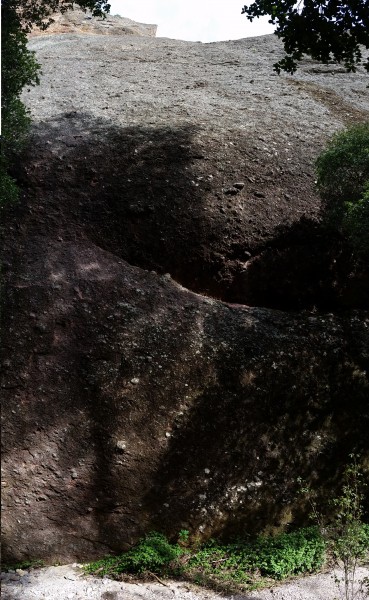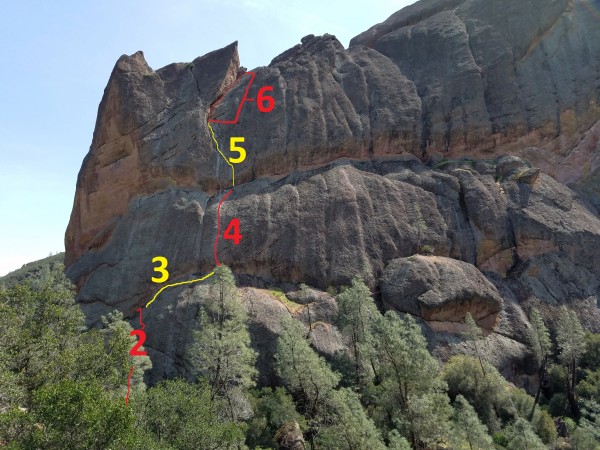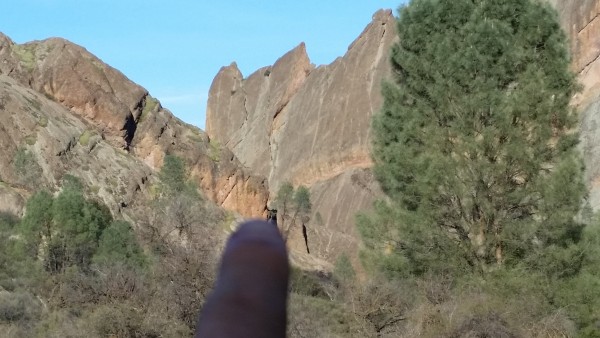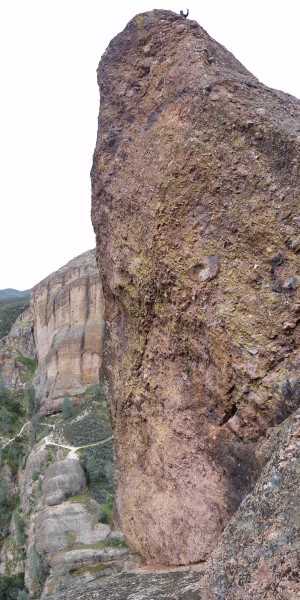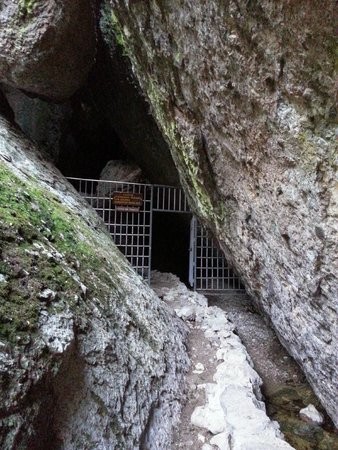Machete Direct (5.8R A1, 6 Pitches), Pinnacles National Park. This was February of 2016...
I had been climbing for about 10 months, having started because of a first-time visit to Pinnacles. We had gone to hike, my girlfriend wanted to see bats. Staring up at all these impressive (and as I would later learn to be: chossy) rock formations, all I could think was, "Holy sh#t, you can climb these things!?"
Flash forward a few months, and I've gotten a gym membership, made a few friends, got some gear, and learned a thing or two. Then I met Liz. We were quick to connect on the stoke level, and started climbing at Pinnacles pretty regularly. Then one day, staring up at Machete Ridge, I told her how badly I wanted to climb it.
"You know which route you wanna do?"
"Yeah, I think Machete Direct would be most feasible."
Next thing you know, 'we're planning for Tuesday.'
Now, my climbing experience thus far was as follows: I had only ever climbed at Pinns; I could lead 5.9, and that was pushing it; I'd done the four-pitch 5.4 Costanoan twice: once guided up it by a friend, and a second time for fun with another; I had never led a trad pitch; and I had zero experience aid climbing.
So now we're about to blast off, and neither of us have aiders. Liz hands me a few slings and says, "you clip it like this and you stand in it like this. If you need to, you can do this to do this." We decide to swing leads "because that's just the best way to do this." Liz goes first.
The first pitch is pretty wild. The original start climbs a tree twenty feet before reaching out to a horizontal crack. Follow the crack left 20 feet until reaching a bolt ladder. Do three aid moves, to a mandatory 5.8 move, to the anchor. An alternate (slightly harder) start bypasses tree by climbing straight up to the bolt ladder, but that start was under a foot of running water. The tree was on a little tiny island that we were just barely able to jump over to.
After carefully watching Liz execute these strange, makeshift aid moves, I set off to follow. It was ugly. Really ugly, with psuedo one arm pullups on quickdraws and stepping on single-runners, quickdraw fifis, and a lot of resting between the three-f*#king-bolts of aid I had to surpass.
But it went, and next thing you know Liz hands me the three draws I need to tackle the second pitch: 100+ ft of sustained 5.7 climbing, three bolts. Did I mention Pinnacles is not known for solid holds?
Before long, I'm atop the second pitch. I'm happy to be alive, but I'm also stoked to report that at the time, it didn't feel like that big of a deal. Looking down 30 feet to your last bolt, and looking up to your next- only a few moves of 5.7 away- a heightened state of awareness keeps the body in check.
Shut the f*#k up brain, now is not a good time to lose it.
"Dude, nice lead."
I hand her some gear and she takes off for the third pitch: Easy 5.3 traverse on nice, loose rock with cams that don't inspire confidence. Knock-knock, holy sh#t, knock knock, that's better...
The fourth pitch is now mine. The starting moves are spectacular: pulling over a slightly overhanging bulge off a big juggy block with 200-and-some-odd feet of exposure below. F*#king heroic. The rest of the pitch is just sustained 5.7/5.8 to the anchor; funtime.
Fifth pitch is hell (if you don't know how to aid climb and you are using an improvised combination of slings and quickdraws in a manner that you still don't understand). Liz leads it: twelve-ish moves of A1 followed by 100 feet of bad ass stemming up a giant flare in the wall, now with four-to-five-hundred feet of glorious exposure to the mini valley below. There's a ridge of rock sticking out of the dihedral the whole way up, and it looks like it would be a plentiful source of holds. Yet it only takes one "knock knock" to hear this 100 ft fin of rock reverberate enough to tell you, "You aint touchin' that. Stem around it."
It probably took me well over half an hour to get up the bolt ladder. And more than once I called up to Liz, "I don't know if I can do this."
"Just keep trying!"
Finally I'm at the anchor. I thought I would never aid climb again.
And the final pitch: 40 ft of 5.8 with 3 bolts (one of which you will never find), until you reach the final section of 5.5 slab: 80 feet of climbing up along the base of "Middle Tower," who sticks out of Machete Ridge's face like Sentinel Rock. Along the base, where this slightly overhung tower protrudes from Machete, there is a crack that offers your source of protection (medium cams).
I have never placed cams on lead. I know how they work (I think). Liz and I discuss whether or not we should stick to the swinging leads policy for this one.
"Probably better if you lead this one, Liz"
Just as she starting racking up, something stupid boils up inside me.
"No. Wait. I need to do this."
Liz smiles devilishly and hands me the gear, and off I go.
The initial 5.8 section goes mostly-uneventfully; I missed one of the bolts, but apparently many before me have done so also. The climbing now slabs up and left to a giant right-facing dihedral (the base of Middle Tower).
Imagine climbing up a really steep slab, with a wall right next to you, on your left. The wall overhangs slightly. At the intersection of your slab and this wall, is a crack. You place your first cam in the crack, 20 feet above your last pro (a bolt). You give the cam a tug, and it rips right out of the wall in a burst of loose flakes.
Oh dear god.
You re-position is, and give it another tug. This time, you watch the lobes sink into the soft rock like a sponge. You look down to the trail, 600 feet below you. You look up at Middle Tower, looming over you while the sun blinds you from above.
Um, I guess I'll keep going...
I find a better placement about 6 feet higher. This one seems to work. I continue up the slab, hugging the dihedral and desperately looking for my next protection opportunity. I look down to see my cam some 30 feet below me, and plug in my first piece of mental pro. Five feet higher, I find a placement that seems a bit better. Cool. Next thing you know, i'm 30 feet from the summit and my eyes are darting back and forth between the summit, the crack, and the valley floor.
F*#k it, this crack sucks anyway.
I pulled over the summit, and gave my first ever howler-monkey scream before shouting 'off-belay.'
When Liz finally pulled over the rim 20 minutes later, she gave me that nervous smile that says, dude what were you thinking.
"We really need to work on you cam placements."
I sheepishly agree, and we head down the standard Machete Ridge Descent (a long adventure in its own, think "North Dome Gully's Tiny Sister").
When we finally hit the trail (on the other side of Machete) we find it to be under two feet of running water. The caves that stand between us and the car are blocked by a gate: "Close Due to Flooding."
Our climb and descent had bypassed the west entrance to the caves, and our only alternative was "to go the long way around."
We said f*#k it, rolled up our pants, took off our shoes, and climbed over the gate. The waterfalls crashing into the caves roared so loudly I was actually a bit intimidated. Exiting the caves requires a bit of now-sopping-wet-scrambling, and then hopping another gate. From there, we had to wade through water up to our shins for a quarter mile until we hit the trail and met up with the base of our Climb.
To this day, every time I pass by the base of Machete Direct, I stop and sit for a minute, staring up at the line, at the climb that completely defined who I am as a climber.
